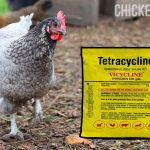Blood in the Egg Yolk
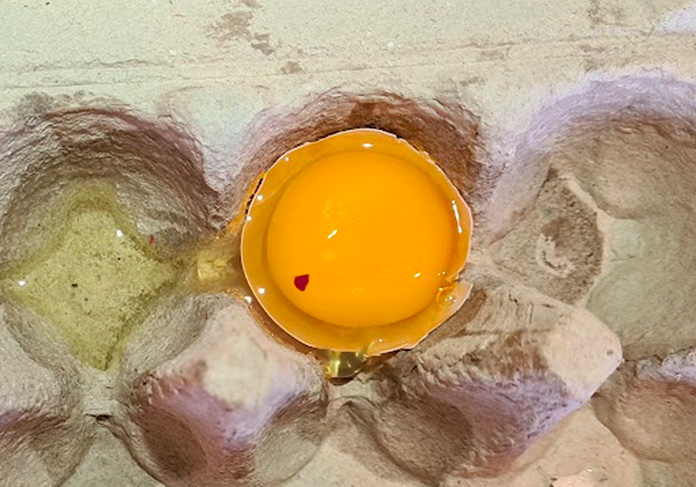
It can be alarming when you notice blood in the egg yolk, but it’s nothing to worry about. The egg is safe to eat, and there is nothing wrong with your hen.
Let’s take a closer look at the blood spots you might encounter in egg yolks.
- Why is there blood in the egg yolk?
- Is it safe to eat eggs with blood spots?
- What causes blood spots in the egg yolk?
- Are eggs with blood spots in the yolk fertilized?
- Is blood in the egg yolk bad for a chicken?
- Difference between blood spots and meat spots in an egg
- Summary
Why is there blood in the egg yolk?
Blood in an egg yolk comes from burst blood vessels in the ovary of a chicken. Every hen is born with several thousand tiny yolks that develop in the ovary, each in its own veined follicle. Fully developed yolks rupture the follicle and its blood vessels, which can result in blood deposits in the egg yolk.
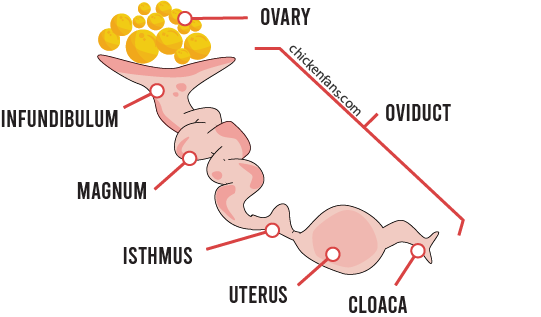
Although the follicle’s surface is covered in a web of tiny blood vessels, it ruptures along a relatively vein-free line called the stigma. Every now and then, there is a blood vessel that crosses the follicular stigma. When such a follicle bursts, a drop of blood can enter the yolk. Sometimes the follicular sac does not rupture along the stigma line, which also results in blood spots in the yolk.
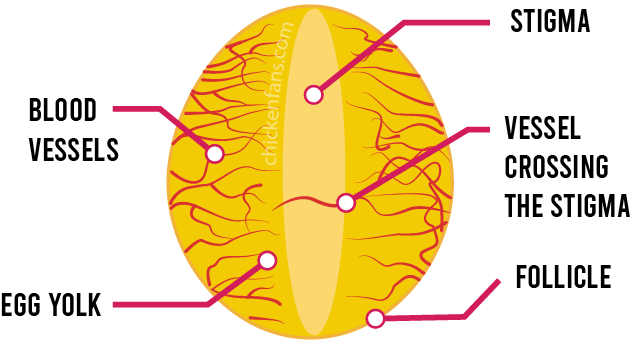
The egg yolk is surrounded by the vitelline membrane that acts as a barrier to protect the yolk. This vitelline membrane keeps the blood clot inside the yolk. When the egg travels further through the oviduct, the egg white (albumen) and eggshell form, but the blood stays in the yolk. Eventually, this results in the red spots you sometimes see when you crack an egg.
Blood spots in the egg white result from burst blood vessels in the magnum, where the albumen develops. Brown spots in the egg white are not always blood. Sometimes they are meat spots, small pieces of the internal lining of the oviduct, as we’ll see later.
Is it safe to eat eggs with blood spots?
Eggs with blood spots are safe to eat. They might not pass the quality control of global commercial-grade egg farms, but they are perfectly edible. If you feel uncomfortable eating blood spots, you can remove them before cooking.
The USDA publishes quality standards for commercial eggs. Article 56.203B in the United States Standards, Grades, and Weight Classes for Shell Eggs (AMS56) specifies that small blood spots (aggregating not more than 1/8inch in diameter) are considered serious defects that do not render the egg inedible. The same holds for meat spots in the egg.
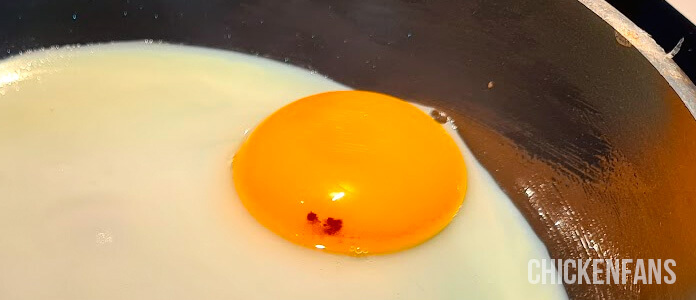
The European Commission regulation No 589/2008 does not mention blood spots as a quality characteristic (art.2) and only mentions the yolk needs to be visible as a shadow on candling.
What causes blood spots in the egg yolk?
Blood spots occur in about 2-4% of eggs. The occurrence varies with the breed and strain of the chicken. You will only encounter blood spots in one to three percent of the eggs in the grocery store. But with backyard chickens, it can be one egg in ten. Some White Leghorn strains will even lay more than 50% of their eggs with blood spots.
Contrary to popular belief, egg color is not a genetic factor in the occurrence of blood clots. In commercially sold eggs, the white eggs are easier to candle and inspect than brown eggs. That’s why you encounter fewer blood spots in white eggs from commercially farmed chickens.
Several environmental factors can increase the incidence of blood spots in the egg yolk:
- Vitamin A deficiencies – various studies on white Leghorns report an increase in blood spots when the vitamin A levels drop below 1000IU per pound (international units). Already in 1961, Hill indicated that 3520 IU/kg (7760IU/pound) was necessary to minimize blood spots in the egg. Vitamin A plays a vital role in the cell tissue of the ovary and the magnum, where the egg white develops. Vitamin A deficiency affects the ovary the most and will primarily result in blood spots in the egg yolk. The NRC established a minimum of 3000 IU/kg for laying hens in 1994, but recent sources recommend around 10,000 IU/kg.
- Vitamin K deficiencies – vitamin K is an essential vitamin involved in blood clotting. Effective blood clotting can prevent blood spots in the yolk when the follicular sac does not rupture along the stigma line and ruptures blood vessels. Vitamin K can be found in several green leafy vegetables and herbs, such as spinach, Brussels sprouts, broccoli, and parsley. Severe vitamin K deficiencies can result in internal bleeding and nosebleeds. Check our guide on vitamin K to understand the importance of vitamin K for chickens.
- Medicines and Poison – some medication against coccidiosis contains sulphaquinoxaline, which is a vitamin K antagonist. Layer diets should always include sufficient levels of vitamin K as a counterbalance. Most commercially available rat poisons rely on a mechanism that depletes the body from vitamin K. If chickens eat from carcasses of poisoned rodents, they can deplete their vitamin K levels.
- Fungal toxins – mycotoxins are produced by fungi, and poisoning can cause several health issues, including mycotoxicosis and ochratoxicosis, known to induce blood clots. Prevent feeding with moldy feed, keep the feed dry in a rodent-proof container and provide proper ventilation.
- Stress – stress due to unusual situations, bad confinement conditions, disturbed lightning programs, or bullying can disrupt the reproductive organs of a chicken
- Metabolism – other factors like blood pressure and age of the laying hen can affect the rate at which hens produce blood spot eggs
Are eggs with blood spots in the yolk fertilized?
No, blood spots in the egg yolk do not mean the egg is fertilized. Both fertilized and non-fertilized eggs can have blood spots in the yolk. The blood comes from a ruptured blood vessel of the laying hen, not from the embryo in the egg. The blood clots do not become the embryo.
Instead, fertilized eggs have a small white spot in the egg yolk, sometimes called the bullseye. If the egg yolk contains sperm when it’s released to the oviduct, the sperm cell attaches to the germinal disc in the yolk and becomes a blastoderm. It’s the white spot you can see on the yolk and it’s the earliest embryo stage.

The blastoderm grows in the white spot when the egg is constructed, but the development stops until the egg is incubated.
Blood vessels only grow from the blastoderm into the yolk when the egg incubates at the correct temperature. If you crack an egg that has incubated for a couple of days, you get a vascular yolk with a clearly defined network of capillary blood vessels and possibly a small embryo.
Is blood in the egg yolk bad for a chicken?
No, blood spots in the egg yolk are normal and occur frequently. It’s an unavoidable side effect of rupturing the vascular follicular sac that contains the egg yolk in the ovary. However, if it happens all too frequently, it might be a clinical sign of an underlying condition.
Chickens that lay eggs with blood spots all the time might suffer from vitamin A or K deficiencies, mycotoxin intoxication, diseases that affect the reproductive organs or live in stressful confinement conditions.
Difference between blood spots and meat spots in an egg
Blood spots come from ruptured blood vessels in the ovary, whereas meat spots are tiny brown pieces of tissue torn from the oviduct. Blood spots usually occur in the egg yolk, and meat spots primarily appear in the egg white.
When egg yolks are released from the ovary, they start their journey through the oviduct. It takes more than 4 hours before they reach the uterus, where the shell is formed. The egg whites and membranes are formed around the yolk during that time. Any shed body tissue that the egg passes will end up in the egg white.
Body tissue is frequently shed from the reproductive organs. The inner surface of the oviduct is lined with epithelial cell layers. If cells of the inner lining get damaged, the body excretes the tissue and creates a new layer of cells. The tissue leaves the body via the egg.
Occasionally, the brown spots in an egg can also be blood spots that have already started to turn brown due to oxidation. This looks very similar to meat spots.
Summary
Blood in the egg yolk comes from ruptured blood vessels in the oviduct during the egg-laying process. When the ovary releases the egg yolk, the follicular sac ruptures, which can deposit some blood in the yolks.
It’s a normal part of nature, and the eggs are perfectly safe to eat. Eggs from the grocery store will contain fewer blood spots as they won’t pass quality control.
The occurrence of blood spots varies per breed but is also influenced by external factors. Vitamin A and K deficiencies, stress, toxins, and diseases can increase the risk of blood spots in the egg.
Finding a blood clot in the yolk does not mean the egg is fertilized. Instead, fertilized eggs have small white spots. Blood vessels will only start to grow into the egg yolk when the egg is incubated at the right temperature.
Sometimes an egg can contain brown spots. These meat spots contain some shed internal lining tissue of the oviduct.
If you want to read more about chicken health problems, symptoms, and diseases, check out our ‘Health Page‘. You’ll find a ‘Symptom Checker‘, a complete list of ‘Chicken Behavior‘, and an overlook of the most common ‘Chicken Diseases‘. Or go to ‘The Classroom‘ and find a comprehensive list of all Chicken Fans articles.
Related Articles:
Egg Binding in Chickens: Symptoms and Treatment (+ Vet Advice)



